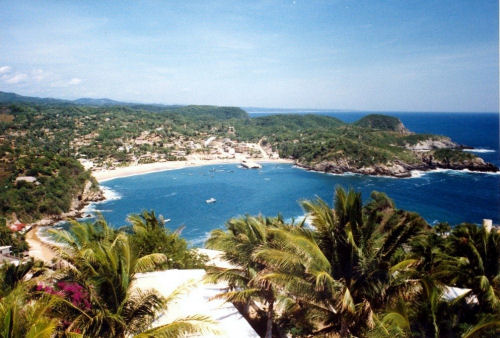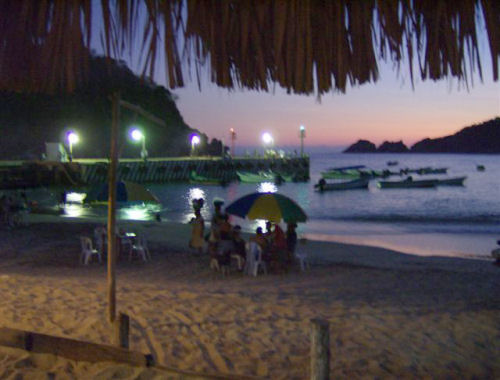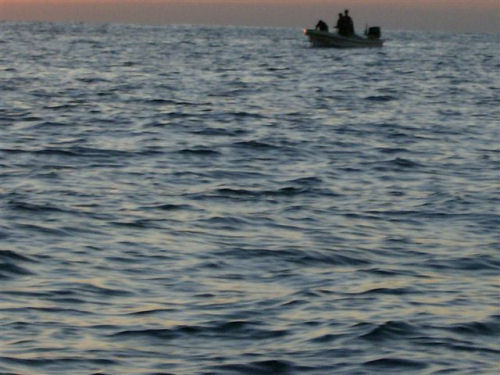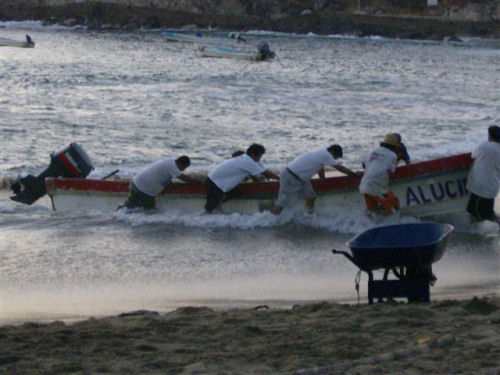
More Photos



|
 More Photos
|
Perhaps, like most of the local fishermen who pass by each morning in the hunt for the “Atun” and “Vela,” the tuna and sailfish, the manta’s are just very glad to be here; a good place to hunt and catch and eat and make a good life for the family.
In the dark mist of the coming morning, as the first light breaks on the blue horizon to the east you can see the twenty-foot panga boats heading out of port, toward the coming red orb that breaks its head on top of the waves a full horizon away. On the good days there is a low bank of clouds crowning the coming light. One sees them gray, then turned to silver, then pink, and finally snow white, matching the blowing wave tops rolling in from the west. To the north, the snake like humps of the Mother Mountains, the Sierra Madres, sit silent and majestic in their quiet way, clothed in the purple robes of their regal presence. After a little time from the bay one feels the cold breeze on the face as the high mountain air sucks down into the waiting arms of the warm blue-green sea. Here is where the good fishing begins as the panga chops into the dark waves, and the eyes grow keen, looking for the schools of "friels" or "cocineros," bait fish for the hungry tuna. These yellow finned twenty-five-pound rockets of the ocean and their cousins, the "barialetas," charge around at high speed, so fast they can outrun a good boat. Trolling must be done with good velocity, the home-made "Rapallas" trailing in three's, shaking and wiggling on the long green lines, enticing the rocket fish so favored by locals and visitors alike.
Slowly, the red ball to the east shows itself as it rises from the depths on the other side of the world. As it erupts from the blue line horizon it shimmers like a ruby volcano, bursting with power, creeping ever upward and flattening on its sides like a compressed explosion. Ever so slowly It emerges from the water and begins to rule the heavens. Then the “Amarillo de Vida,” the yellow of the life giver, breaks through at the crown. Almost clear of the water now, the yellow creeps over the top then downward. As the last drops of the combusting star cling to the sea the dark rippling waves in its path lay down a red carpet all the way to the boat. For the fisherman it is as if he has made a welcome for the giver of life. “Gracias a Dios,” again, one day more on the sea.
One can witness it a thousand – no, ten thousand times and still be stirred; moved in the center place of the “pecho” where the heart lives, the place where one goes to meet and talk with his God. And he wonders, maybe this is why the Manta’s fly in the early morning, to try and reach the home place, the place of the eternal birthing, the place where we were before we were here.
But a fisherman must pull his eyes away from the magic, no more time for this now; the gasoline is burning through the quick mounted horses inside the Ya-Ma-ha “moto,” pushing us along to try and fool the tuna. The Rapallas wiggle, one line on each side, half-hitched on the ends to the cross-beam “palo,” the long pole of ocotillo wood from the mountains, cut only with the really sharp blade. The third line, “la Trinidad,” the holy breath, the one for luck, is tied to the back of the seat ahead and it runs over the thigh as one sits at the moto, and it bites a little when come the Atun.
They usually come in bunches, all at once, the green lines jerked tight. First one, perhaps on the palo, then maybe another on the other side, and "gracias a Dios" they sometimes come in threes. One can slow only a little, kicking over the arm of the moto to one side to make the slow circle, hoping the lines do not tangle as "mano por mano" hand over hand, the line is pulled in. Sometimes the fish is too big with his pull and a man can only hold on to what he has, as the great Atun fights for his life, arching away from the strange sounding machine that makes a trail and the pull on the mouth to go where he would not. The green line cuts into the hands but the worn gloves do their job and the blood does not come. Only when the Great Eater of Fish grows tired can one make progress in pulling him in. Or when he is foolish and jumps out of the water, losing his great power, he can be pulled in quickly on his side, flapping and slapping in desperation on top of the waves. Then, when he is close to the boat, "Arriba!," up and into the air and over the side to be slung into the floor between the seats. With practice one can grab the Rapalla with one hand to shake it loose from the mouth and throw it back out again, quickly back to work for maybe another. But sometimes, "Aye, chingala!" it requires the two hands, grabbing the Barialetta behind the neck to open his mouth and jerking loose the forked tail deceiver from the razor sharp teeth.
In a frenzy the fish come in as the boat slowly circles the rabid mob, slashing into the submarine cloud of flashing, silver Cocineros. Breakfast in the sea; for the bullet-fast Atun it is death all around for the sake of just living. Then they go. As the bait school seeks shelter away from the surface the bloody circus sinks down, too far for the whizzing Rapallas to do their magic. Then it is quiet again, except for the drone of the moto.
On to the next school, “ohala que si,” or at least one hopes so.
Again, the Manta’s jump and try to fly as you pass by. On the good days they seem to sing: “bravo, marinero, gran pescador;” good job, man of the sea, great fisherman. “Andale;” get on with it.
Dr. John Bomar recently returned from a vacation in Puerto Angel, Oaxaca, Mexico.